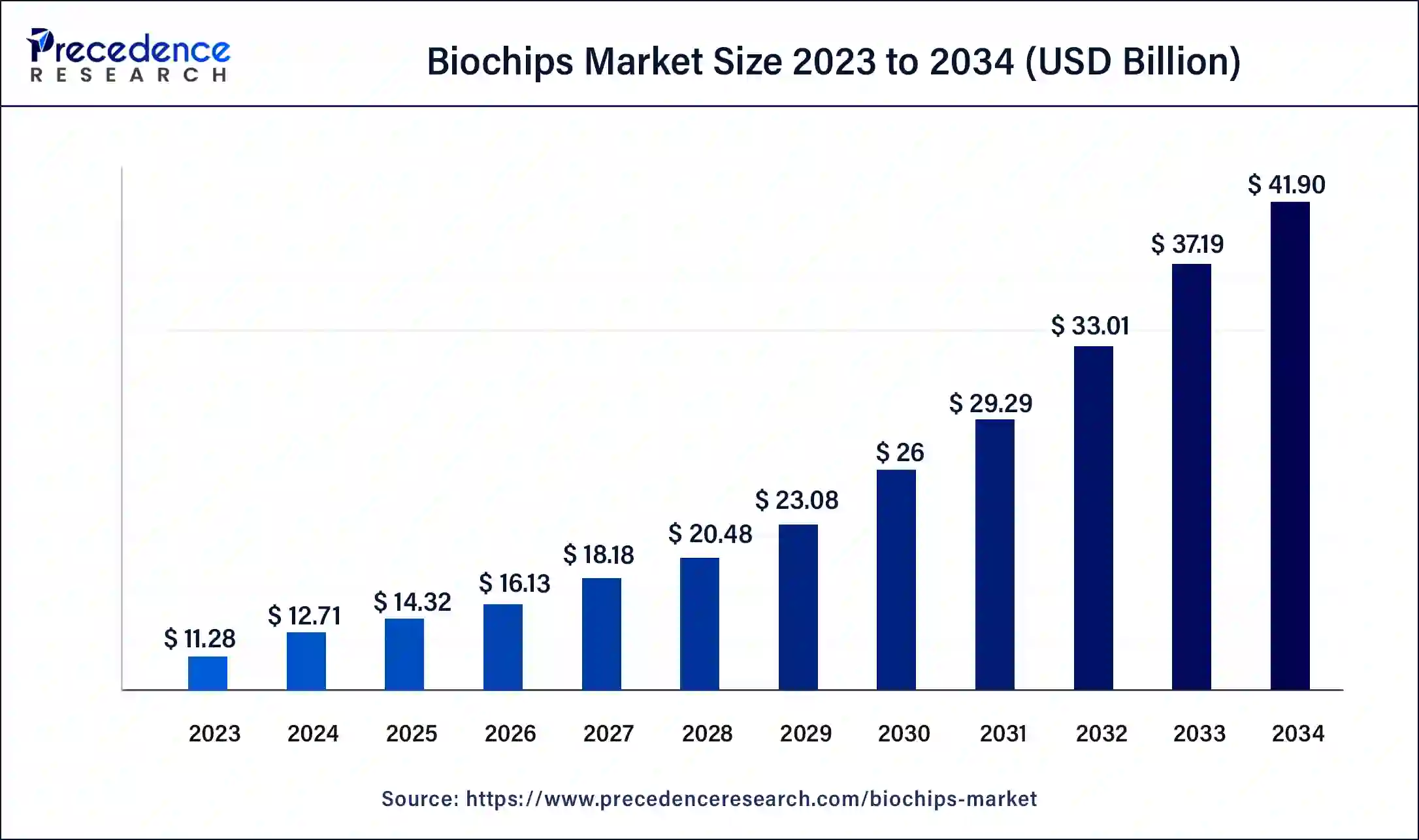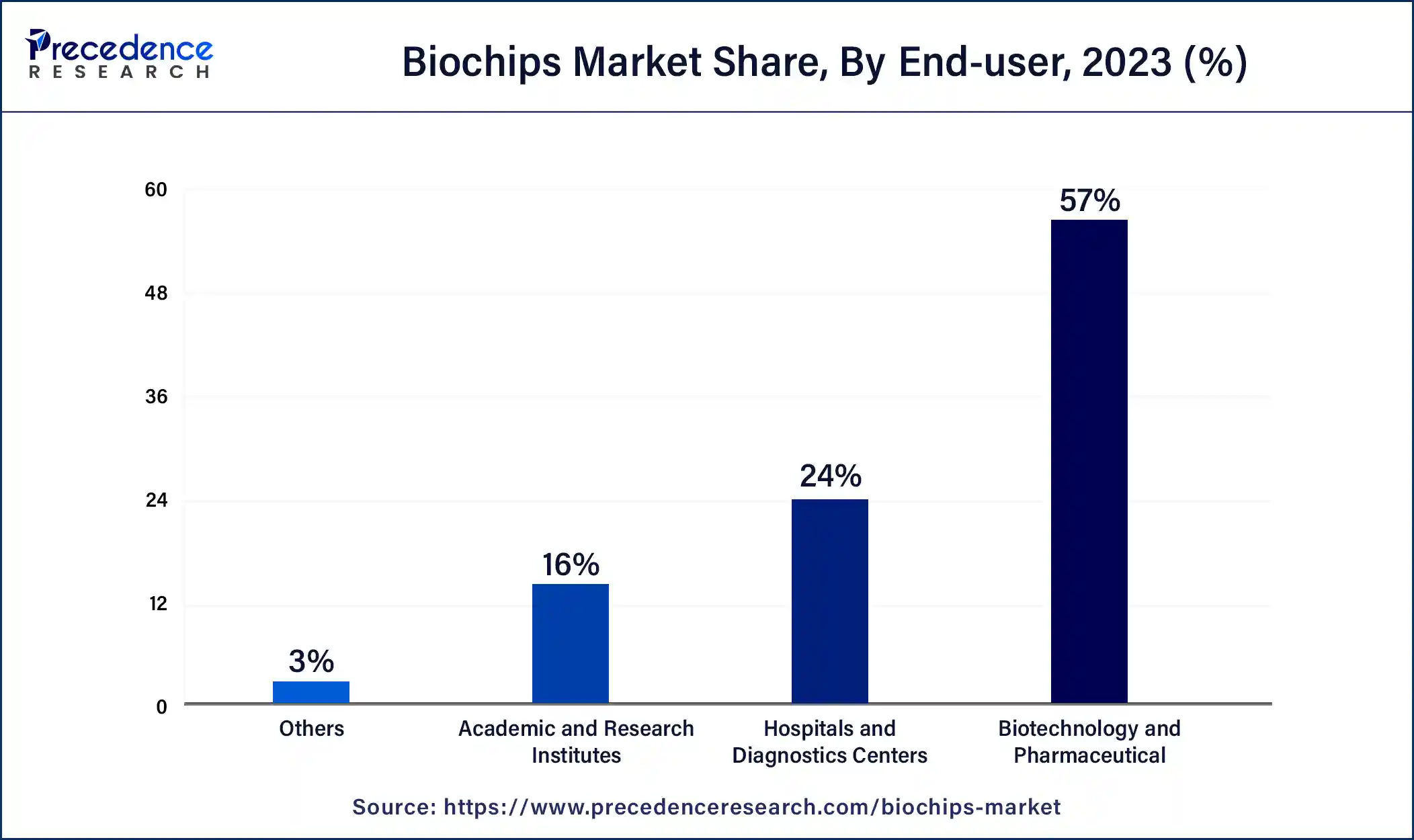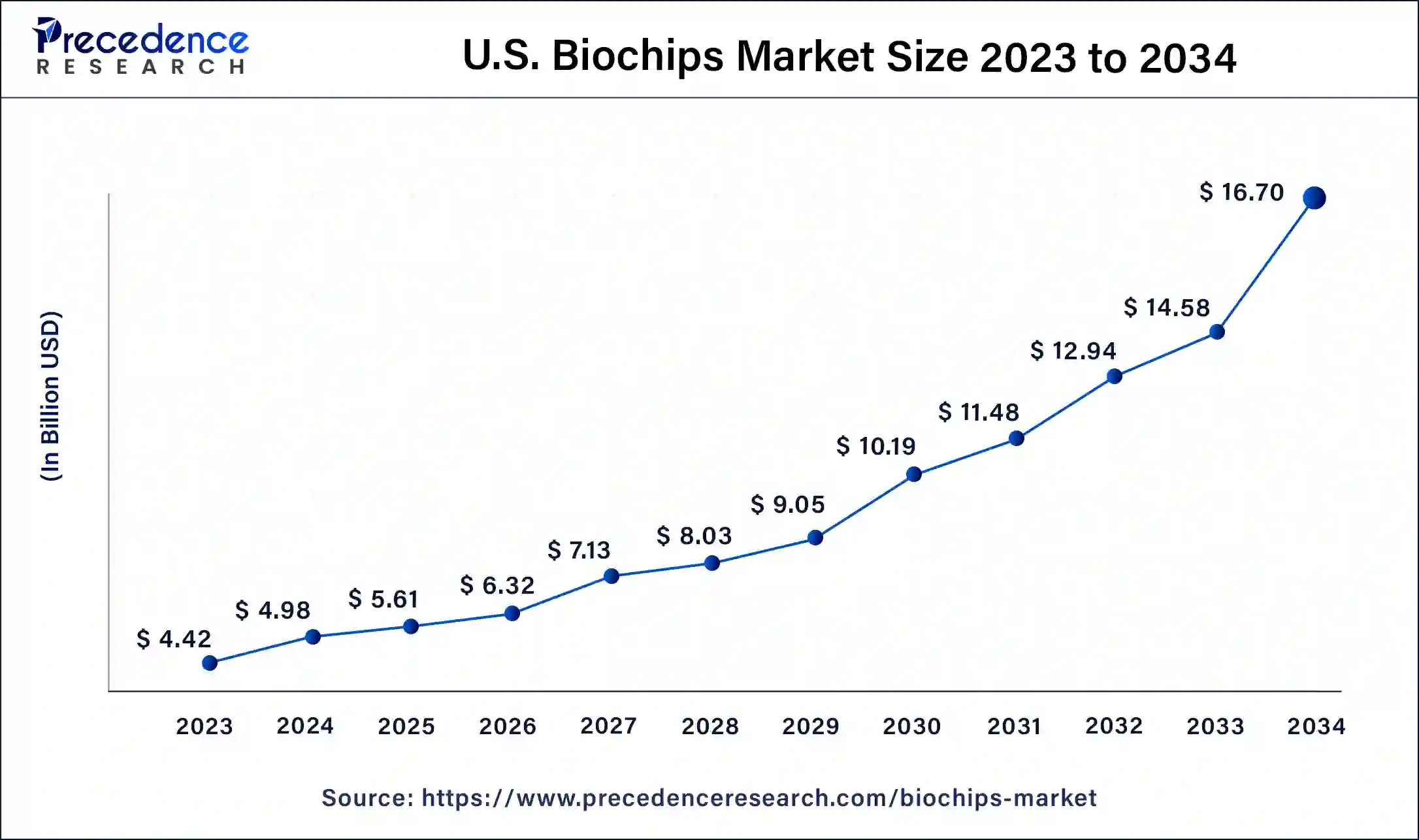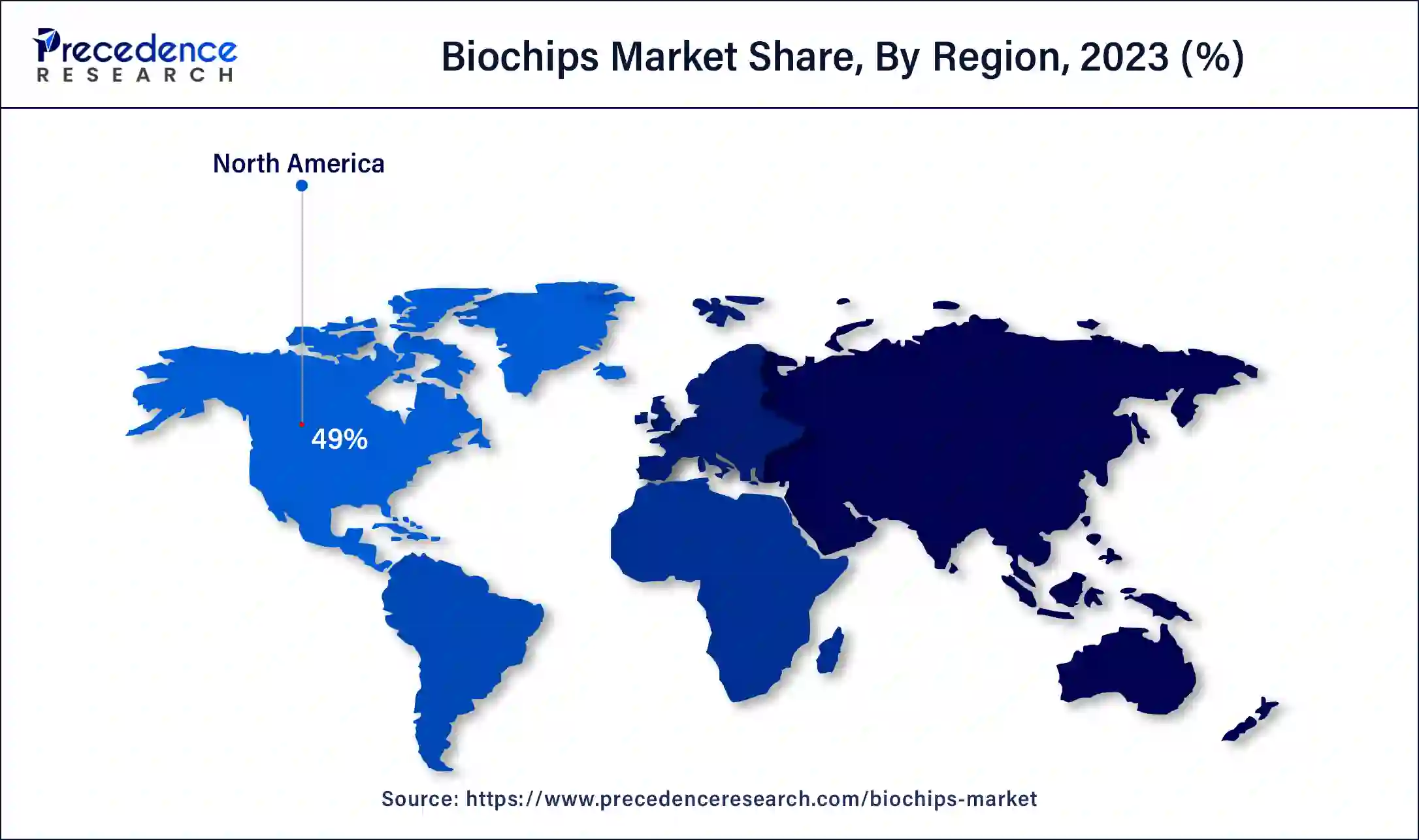List of Contents
What is the Biochips Market Size?
The global biochips market size is valued at USD 14.32 billion in 2025 and is predicted to increase from USD 16.13 billion in 2026 to approximately USD 41.90 billion by 2034, expanding at a CAGR of 12.67% from 2025 to 2034. The North America biochips market size reached USD 5.53 billion in 2023. The biochips market growth is attributed to increased application in various healthcare settings.

Biochips Market Key Takeaways
- North America dominated the biochips market with the largest market share of 49% in 2024.
- Asia Pacific is expected to grow at the fastest CAGR in the market during the forecast period.
- By type, the DNA chips segment has held a major market share of 36% in 2024.
- By type, the lab-on-chip segment is projected to grow rapidly in the market in the future years.
- By fabrication technology, the microarrays segment held the largest share of the market in 2024.
- By fabrication technology, the microfluidics segment is projected to grow rapidly in the market in the future years.
- By end user, the biotechnology & pharmaceutical companies segment has generated the highest market share of 57% in 2024.
- By end-user, the academic & research institutes segment is projected to grow rapidly in the market in the future years.
Market Overview
Biochips are microsystems that perform thousands of biochemical operations at the same time and are, therefore, considered indispensable in molecular biology. These devices are widely used in a number of different fields, such as genomics and proteomics, as tools for high throughput screening and analysis. The biochips market products and solutions are widely employed in molecular diagnostics for biomarkers and genetic profile identification, drug discovery, and testing for the efficacy of therapeutic candidates.
Computerized medicine, the demand for individualized medicine enhancement in genomics technology, and the growing rate of long-term ailments are also credited to the growth of the biochips market. The incorporation of biochips with upcoming technologies, such as artificial intelligence and machine learning, will improve their analysis abilities and increase their portfolio demand, which will further boost the market. Moreover, the innovation and advancement in these fields of specialization, such as biotechnology and pharmaceuticals, further fuel the biochip application across the various sectors.
Impact of AI on the Biochip Market
The combination of biochips with AI/machine learning helps to increase the reliability of data analysis and, therefore, a more accurate prognosis of treatment outcomes and disease progression. In the pharmaceutical industry, biochips are used to help the rapid development of drugs and get new therapies to the biochips market.
Biochips Market Outlook
- Industry Growth Overview: The biochips market is projected to witness robust growth between 2025 and 2034, as healthcare systems shift toward molecular-level diagnostics and personalized decision-making in therapeutic interventions. The need for genomic and proteomic analysis in oncology, cardiology, and infectious disease management has driven the adoption of biochip technology in clinical laboratories. Large-scale purchases of microarray and lab-on-chip technologies are being fueled by the growth of sequencing programs worldwide.
- Technological Innovation:Technological innovation is transforming the market, with major players advancing microfluidics, nano-patterning, and multi-omics integration to achieve higher accuracy and faster analysis times. With advances in technology, microarrays have become capable of high probe density, allowing the measurement of thousands of biomarkers from small amounts of samples. Signal processing with AI augmentation is being integrated into next-generation systems, enabling more sensitive analysis and rapid interpretation of complex genomic and proteomic data.
- Global Expansion:Leading manufacturers are expanding globally to position themselves near rapidly growing genomics and clinical diagnostics hubs. Countries like China, Singapore, South Korea, and India are heavily investing in genomic sequencing, precision oncology, and translational research facilities. The rising demand is being addressed by re-establishing distribution networks, technical support centers, and training facilities in Southeast Asia and the Middle East by companies such as Bio-Rad, Standard BioTools, GE HealthCare, and QIAGEN.
- Major Investors:Major investors in the market include venture capital firms such as Flagship Pioneering and RA Capital, which provide critical early-stage funding to startups developing next-generation diagnostic and multi-omics platforms. Additionally, large diagnostics and biotech corporations like Thermo Fisher Scientific and Roche strategically invest in or acquire biochip technology firms to integrate proprietary chip architectures and accelerate innovation in precision diagnostics.
- Startup Ecosystem:The startup ecosystem in the biochips sector is rapidly expanding, with new companies focusing on innovations in microfluidics, next-generation biosensors, graphene-based biochips, and portable diagnostic devices. Most of these startups address gaps in oncology, reproductive health, infectious disease testing, and population genetics by offering more scalable, faster, and affordable testing solutions.
Biochips Market Growth Factors
- Innovation in microarray and lab-on-a-chip technology enhances biochip capabilities, making them more efficient and cost-effective.
- Increased funding and investment in life science research boost the development and adoption of biochips for drug discovery and molecular diagnostics.
- The expanding fields of genomics and proteomics leverages biochips technology for high-throughput analysis and discovery.
- High drug development pipelines are also in a position to contribute to profile the growth of the biochips market to a maximum level. These pipelines demand a high throughput analysis and the molecular descriptors in detail that biochips generate effectively.
- Supportive government policies and funding for biotechnology and healthcare innovation foster the biochips market growth.
Market Scope
| Report Coverage | Details |
| Market Size by 2034 | USD 41.90 Billion |
| Market Size in 2026 | USD 16.13 Billion |
| Market Size in 2025 | USD 14.32 Billion |
| Market Growth Rate from 2025 to 2034 | CAGR of 12.67% |
| Largest Market | North America |
| Base Year | 2024 |
| Forecast Period | 2025 to 2034 |
| Segments Covered | Type, Fabrication Technology, End-user, and Regions |
| Regions Covered | North America, Europe, Asia-Pacific, Latin America, and Middle East & Africa |
Market Dynamics
Drivers
Impact of chronic disease prevalence on biochip adoption
The growing prevalence of chronic diseases is likely to boost the adoption of biochips in the healthcare sector. Congenital and lifestyle diseases, including cardiovascular diseases and cancer, create the need for early and accurate diagnosis, which is where biochips are utilized. They help to monitor chronic diseases with less invasiveness and frequency. Biochips offer healthcare practitioners constant information on the state of health of the patient, which is very useful with chronic diseases. The integration of biochips in wearable gadgets and home monitoring systems also increases the level of compliance and participation of the patient in managing their illness. Additionally, the reduction of healthcare costs by avoiding the worsening of diseases and hospital admissions increases the adoption of biochips, which further propels the market.
- According to the report published by the U.S. Department of Health & Human Services in February 2024, around 129 million people in the U.S. are suffering from at least one chronic disease.
Increasing demand for personalized medicine
Increasing demand for personalized medicine is anticipated to drive the market in the coming years. The trend of the individualized approach to molecular diagnostic tools helps doctors assess their genetic profile as accurately as possible. Through the use of biochips, genetic mutations and biomarkers are vital in the determination of the appropriate treatment; hence, targeted therapy that is widely used in precision medicine is detected. Further, the possibility of producing biochips for individual use means that they will always fit into the latest developments in personalized medicine. Given the dynamics of the increase in the use of individual treatment plans based on genetic profiles, biochips will be even more important within clinical medicine in the future.
Restraint
Impact of high costs
High costs of biochip technology are likely to hamper the market growth. These costs reduce the affordability of biochips and restrict the reach of small health facilities. High costs are also inevitable when carrying out biochip-based diagnostics. This necessarily inflates the cost of the diagnostic tests, thus making it a preserve of the financially capable. Moreover, the growing shift of potential parties towards affordable healthcare technology further hinders the biochips market in the coming years.
Opportunity
Advancements in nanotechnology enhancing biochip development
Surging advancements in nanotechnology enhancing the development and functionality of biochips are projected to create immense opportunities for the players competing in the market. The application of nanotechnology in the development of biochips results in the development of smaller, better-performing, and high-sensitivity devices. These nanotech-revamped biochips are capable of detecting very low concentrations of biological species, and on this front, they are quite useful in early disease diagnosis and screening. Developers are combining nanotechnology with the development of precise and trustworthy next-generation biochip diagnostic devices. Additionally, the use of nanomaterials enhances biochip stability and minimizes background noise, hence enhancing the precision and reliability of the results. All these factors will further boost the biochips market in the coming years.
- According to a report published by the National Library of Medicine in September 2023, nanotechnology has the potential to revolutionize healthcare and medicine. Nanotechnology involves manipulating materials at a very small scale, where their properties significantly differ from their bulk counterparts. This allows for precise control of their physical, chemical, and biological properties, potentially transforming the way we diagnose, treat, and prevent diseases.
Regional Insights
Type Insights
The DNA chips segment dominated the market with the largest market share of 36% in 2024 due to their application to genomics and tailored medicine. Microarrays or DNA Chips enable a number of thousands of genes to be analyzed at the same time and are widely used in gene expression profiling, genetic variation, and disease studies. The current and rising focus on personalized medicine necessitates the use of DNA chips as they provide the necessary broad genetic data on individual patients. Furthermore, the development of DNA chips, including an increase in their sensitivity and resolution, offering improved data to researchers and clinicians, further boosts their demand.
The lab-on-chip segment is projected to grow rapidly in the biochips market in the future years owing to its high utilization in diagnostics and medical testing. LOC devices combine several laboratory applications into one chip while being cheap and portable. They found that the rising trend in point-of-care diagnostics and decentralized health systems is facilitating LOC technology. The evolution in microfluidics and material science adds to the performance and versatility of the LOC devices that open up their application in the diagnosis of infectious diseases and chronic diseases. Furthermore, telemedicine and other remote healthcare solutions are also creating demand for LOC technology, as these devices can easily be incorporated into home-based and mobile testing applications.
- According to the report published by the National Library of Health Statistics in November 2023, around 10.2 million people often visit physicians for their infectious or parasitic diseases.
Fabrication Technology Insights
The microarrays segment held the largest share of the biochips market in 2024 due to their versatility use in genomic and proteomic studies. Microarrays are rapid and analyze thousands of genes or proteins at the same time, thus making them useful in large-scale studies or biomarker identification. The feature that renders them most valuable is the ability to give high sensitivity and the capacity to pick out two or more targets within one assay. Furthermore, microarray technology has experienced improvements in the cost of the technology and the development of better data analysis tools, which will further propel the segment in the coming years.
The microfluidics segment is projected to grow rapidly in the biochips market in the future years owing to its efficient way of dealing with small volumes of fluids. Microfluidic devices provide fast and precise measurements, which is useful for point-of-care diagnosis and molecular targeting. Their portability and high-throughput capabilities make them usable in various processes. Furthermore, there are continued technological innovations in lab-on-a-chip systems, better fabrication approaches, and improvements in microfluidic engineering. All these factors further boost their demand.
End-user Insights
The biotechnology & pharmaceutical companies segment dominated the biochips market in 2024. Biochips are used by biotechnology and pharmaceutical companies in the development of new drugs and high-throughput screening of compounds and biological markers. The thesis of the use of biochips in genomic and proteomic biomarker discovery is driven by the fact that it expedites the identification of drug targets and the development of personalized drugs. They also use biochips to perform clinical trials, and they use the chips to monitor the responses of patients to the new treatments. Additionally, the increased adoption of biochips in personalized medical care will further fuel the biochips market in the coming years.

The academic & research institutes segment is projected to grow rapidly in the biochips market in the future years owing to the increasing emphasis on science and advanced studies in the field of biotechnology. These institutions are heavily dependent on biochips as these chips are used in scanning genomics, proteomics, molecular biology, and a lot more. Biochips equip researchers with the opportunities to execute highly sensitive, multiple analyses simultaneously, which is essential in the progress of sciences and the formation of technologies. The rise in the availability of research funds for projects and grants focused on diseases' pathways and new therapeutics, in particular, requires the use of biochip technologies. Furthermore, the partnerships between academic and industrial entities are expected to increase the usage of biochips in research facilities and expand its possibilities.
Regional Insights
U.S. Biochips Market Size and Growth 2025 to 2034
The U.S. biochips market size is exhibited at USD 5.61 billion in 2025 and is projected to be worth around USD 16.70 billion by 2034, poised to grow at a CAGR of 12.84% from 2025 to 2034.

North America dominated the biochips market in 2024 due to its well-developed healthcare structure, high research and development investment, and highly developed key players. America and Canada both have a strong presence in the biotechnology and pharmaceutical industries, which creates a high demand for biochips used in drug development, detection, and treatment associated with personalized medicine.
Large and healthy expenditure on healthcare, along with a stringent regulatory environment, contributes to the increased use of exploitative biochip technologies. Additionally, collaboration between research institutions and universities that work closely with industry players in the development of biochip uses further boosts the market in this region.
- According to a report published by the National Library of Medicine in January 2023, the number of drugs with personalized indications for their use increased by 70% from 2015 to 2020.
U.S. Biochips Market Trends
The biochips market in the U.S. is growing due to the country's leadership in genomics, precision oncology, and molecular diagnostics, which drives demand for advanced diagnostic technologies. Extensive use of microarray and lab-on-chip platforms across hospitals, academic institutions, and national research centers further supports market expansion. This widespread adoption of cutting-edge biochip technologies positions the U.S. as a dominant and innovative hub in the global market.

What Makes Asia Pacific the Fastest-Growing Region?
Asia Pacific is expected to grow at the fastest CAGR in the biochips market during the forecast period owing to the growing healthcare industry, emerging investments in biotechnology solutions, and trends such as personalized medicine. China, India, and Japan are utilizing biochip technology to cater to large populations and the growing cases of chronic diseases. Additionally, an increase in the middle-class population and better availability of healthcare in the Asia Pacific further fuels the need for high-level diagnostics and biochips.
- According to the report published by the 2023 Asia Pacific Population and Development Report, Asia Pacific is home to around 60% of the global population.
China Biochips Market Trends
In China, the market is growing due to significant national investment in genomics programs and research infrastructure. Adoption of microarrays, biosensors, and microfluidic biochips is increasing across public hospitals and research centers, supporting large-scale precision diagnostics. Additionally, government-backed initiatives like the China Precision Medicine Initiative are driving demand for ultra-high-throughput analysis platforms, further accelerating market growth.
How is the European Biochip Market Expected to Grow?
The biochip market in Europe is expected to experience significant growth over the forecast period. Led mainly by the established infrastructure of healthcare and the effective clinical research sector of the region. Nations such as the UK, Germany, and France are engaging in biotechnology and precision medicine on a massive scale, thus boosting the demand for novel diagnostic tools such as biochips. Biochips allow faster and more exact analysis of genetic material and biomarker development for early detection of disease.
UK Biochips Market Trends
With the high incidence of cancer and the growing population of chronic diseases like cardiovascular disorders and diabetes, the UK biochip market is going to grow dramatically. Moreover, favorable government regulations, research project funding, and efforts to speed up clinical diagnostics are driving the growth of the market.
What's Driving Growth in the Middle East & Africa Biochip Market?
The biochip market in the Middle East & Africa is expected to experience substantial growth over the forecast period. Powered by the increased prevalence of cancer and the broadened acceptance of advanced diagnostic solutions. Moreover, the partnership between local healthcare providers and international biotech firms has led to an increased rate of biochip technologies. The MEA region is likely to enhance its diagnostic capabilities and improve how it manages unmet medical needs is linked to the rapid technological developments taking place on the biochip platforms.
Saudi Arabia Biochips Market
As a major market in MEA, Saudi Arabia is emerging as an attractive investment as the government is getting more involved in the modernization of healthcare solutions, and more people are getting familiar with the advantages of non-invasive diagnostics operations. Investment in healthcare infrastructure and improvement in diagnostic technology by the Saudi government have resulted in higher accuracy and accessibility of diagnostic services.
What Opportunities Exist for the Biochips Market in Latin America?
Latin America presents significant opportunities for the market due to rising demand for advanced diagnostic services in oncology, infectious diseases, and reproductive health. Investments in modernizing clinical laboratories in countries like Brazil, Mexico, Colombia, and Chile are expected to drive the adoption of microarray-based testing and portable lab-on-chip platforms. These factors significantly create a favorable environment for expanding biochip technologies across both clinical and research settings in the region.
Brazil Biochips Market Trends
Brazil is the leading biochips market in Latin America, driven by a growing number of diagnostic facilities. The expansion of individual laboratories and multinational diagnostic chains is increasing demand for high-throughput biochip systems. Additionally, rising interest in early diagnosis and preventive healthcare is expected to sustain long-term regional demand for advanced biochip technologies.
Biochips Market – Value Chain Analysis
Raw Material Sourcing
Biochip production begins with sourcing core materials, including silicon wafers, polymers, glass substrates, biomolecules, microfluidic materials, and reagents essential for probe immobilization and assay development.
- Key Players: Corning Incorporated, SCHOTT AG, Dow Inc., Merck KGaA.
Component Fabrication
Raw materials are processed into functional elements, including DNA probes, protein capture molecules, microfluidic channels, electrodes, and surface chemistries required for high-performance biochip sensitivity and specificity.
- Key Players: Thermo Fisher Scientific, QIAGEN, PerkinElmer, Agilent Technologies.
Biochip Manufacturing & Microarray Printing
Manufacturers integrate fabricated components into complete biochips using lithography, deposition, spotting, and microarray printing technologies for genomic, proteomic, and diagnostic applications.
- Key Players: Illumina, Standard BioTools, Bio-Rad Laboratories, Randox Laboratories.
Instrumentation & System Integration
Biochips are bundled with scanners, imaging systems, microfluidic controllers, and analytical software to create fully integrated platforms for clinical diagnostics, genomics, and research workflows.
- Key Players:GE HealthCare, Agilent Technologies, Thermo Fisher Scientific, PerkinElmer.
Distribution & Deployment
Final biochip platforms are distributed to end users, including research institutions, clinical laboratories, biopharma companies, and diagnostic centers, using global supply networks.
- Key Players: Thermo Fisher Scientific, QIAGEN, Illumina, Bio-Rad Laboratories.
End-Use Applications
Biochips are utilized for genomic sequencing, disease diagnostics, proteomics profiling, drug discovery, and personalized medicine, driving adoption across healthcare and biotechnology sectors.
- Key Players (End Users): Mayo Clinic, Labcorp, Quest Diagnostics, Pfizer, Novartis.
Top Companies in the Biochips Market & Their Offerings
- Thermo Fisher Scientific, Inc.: A global leader providing advanced biochip platforms for genomic analysis, precision medicine, and high-throughput molecular diagnostics.
- Standard BioTools (U.S.): Known for its high-resolution microfluidic biochips used in single-cell analysis and proteomics research.
- Randox Laboratories Ltd (UK):Offers multi-analyte biochip arrays enabling rapid clinical diagnostics across infectious diseases, cardiac markers, and oncology.
- QIAGEN (Germany): Delivers biochip-based sample preparation and molecular testing solutions widely used in personalized healthcare and biomarker discovery.
- PerkinElmer Inc (U.S.): Provides innovative biochip technologies for drug discovery, toxicology screening, and high-content biological analysis.
- LI-COR, Inc. (U.S.): Specializes in fluorescence-based biochips for protein detection, imaging, and quantitative Western blot workflows.
- Illumina, Inc. (U.S.): A leading provider of microarray biochips designed for large-scale genotyping, gene expression studies, and population genomics.
- GE HealthCare: Develops high-performance biochip and microarray systems supporting clinical diagnostics, protein profiling, and translational research.
- Bio-Rad Laboratories, Inc. (U.S.): Offers multiplex biochip platforms for genomics, proteomics, and clinical laboratory applications.
- Agilent Technologies, Inc. (U.S.):Provides advanced microarray biochips for gene expression, epigenetics, and precision oncology research.
Recent Developments
- In January 2025, Coherent Corp., a worldwide expert in laser and photonic solutions, launched new pin-hole array biochips for medical diagnostics, aimed at gene sequencing applications.
(Source: https://www.coherent.com) - In March 2024, Randox Laboratories Ltd, a Northern Irish health and toxicology company, launched a new biochip that detects the genetic risk of type 1 diabetes. It is the first test in the world to use genetics to quickly identify individuals at high risk of developing type 1 diabetes. Randox developed this test in collaboration with JDRF-funded researchers at the University of Exeter.
- In April 2024, BMF Boston Micro Fabrication launched BMF Biotechnology Inc. to advance the use of 3D BioChips in pharmaceutical and cosmetic research. BMF Biotechnology Inc. is focused on developing and commercializing innovative BioChips, specifically organ-on-a-chip platforms, to cultivate large-scale tissues in vitro. This innovation will help accelerate the development of new drugs and cosmetics.
Segments Covered in the Reports
By Type
- DNA Chips
- Lab-on-Chip
- Protein Chips
- Tissue Arrays
- Others
By Fabrication Technology
- Microfluidics
- Microarrays
By End-user
- Biotechnology & Pharmaceutical
- Academic & Research Institutes
- Hospitals & Diagnostics Centers
- Others
By Geography
- North America
- Asia Pacific
- Europe
- Latin America
- Middle East & Africa
For inquiries regarding discounts, bulk purchases, or customization requests, please contact us at sales@precedenceresearch.com
Frequently Asked Questions
Ask For Sample
No cookie-cutter, only authentic analysis – take the 1st step to become a Precedence Research client



